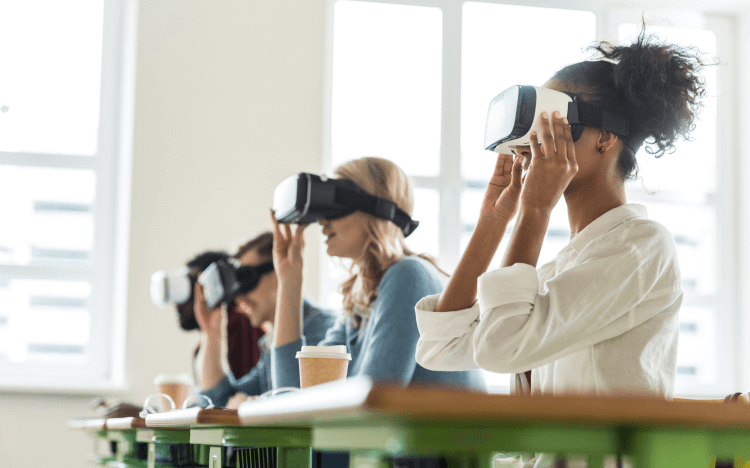Last year, applications to Online MBAs grew 46%, proof that the shift to remote learning has altered the business school landscape. Now, almost half of business schools have started offering their own online microcredentials.
Education technology—Edtech for short—has been key in driving this movement. Sophisticated technologies are now available that can enhance the student experience, and business schools are increasingly relying on Edtech to teach Online MBAs.
The rise of Edtech in the classroom
Edtech refers to the use of hardware or software to supplement the learning experience. The most significant and widely adopted example came during the early days of the pandemic, when classes moved to virtual teaching.
Students—many of whom were scattered across the globe—were forced to log in to online sessions via video conferencing platforms such as Zoom and Microsoft Teams. Within weeks a large-scale shift occurred as the vast majority of business schools adopted a fully remote model.
But while this was born out of necessity, business schools quickly began to use Edtech to develop the learning experience.
Spain’s IE Business School upgraded microphones and cameras in the classroom to enhance the link between faculty and students. The school also implemented software that would project students’ faces onto a large screen as if they were in the room with their professor.
“Since we have technology that enables us to do things in better ways, we will use it,” explained IE executive MBA director, Paula Robles, at the time.
By late 2021, 75% of business schools were using virtual classrooms. Realising the benefits that technology could bring to the learning experience, a further 82% had plans to invest in Edtech moving forward.
Considering an Online MBA?
Download our Online MBA Guide 2023
What key technologies are being used?
So where are we now with Edtech? Well, the technologies in use in the classroom are ever-changing, in line with the evolution of Edtech.
Some of the most exciting developments involve virtual reality (VR). A recent study by PwC found that VR headsets, which surround you with an immersive reality of your choosing, help users learn four times faster than traditional learners.
INSEAD, one of the world’s top business schools, recently invested heavily in VR as a means to aid teaching. VR has allowed INSEAD students to take part in case-based interactive sessions that include visiting wet markets in Singapore and running juice bars in Zanzibar.
Birmingham Business School is also looking at incorporating VR into its Online MBA and other distance learning degrees. Andrew Parker, director of digital education and distance learning at Birmingham, feels VR can have a large impact on the student experience.
“Our students are desperate for access to experts or more situations where they can get involved in things,” he says.
Traditional case studies can be transformed by VR, he adds: “if I want to go and visit a factory and walk through it, the technology is getting there now when you can go and do that without ever leaving your desk.”
Artificial intelligence (AI) is another key area being explored. Business schools are increasingly emphasising personalization as part of the student experience, AI can be used to supplement this.
POLIMI Graduate School of Management uses AI to provide personalized learning recommendations for students on its online Flex Executive MBA. This includes course suggestions that align with your career goals.
Another possible use for AI are notifications—referred to as 'nudges'—that would remind you to return to your work after taking some time off your studies.
Schools are also using data analytics to monitor student engagement and check who requires support. Equally, gamification methods such as hackathons and virtual business games are being implemented to offer different ways of learning for students.
What’s the impact of Edtech on students?
Edtech innovations have drastically changed the student experience. Virtual classrooms no longer require all students to be present at the same time, meaning many schools now incorporate a mixture of asynchronous and synchronous learning.
This makes studying an Online MBA more flexible, allowing students to better balance work and home life.
“The distance learning experience proved to have immense value,” says Agustina de Marrote, a student on the POLIMI Flex Executive MBA. “I was in-between countries. Brexit pushed my partner back to Italy, and I needed the flexibility to manage that uncertainty.”
Studying in a tech-led environment also helps prepare students for life after graduation. While digital transformation has been shaping business for years, the business world underwent similar changes to the education space during the pandemic, and students are increasingly seeking jobs that offer at least some remote work.
Learning how to use the technologies that underpin a hybrid or remote workplace is good preparation for what’s to come. It’s equally important that students are able to work with teams they may not physically interact with daily.
“It’s about building habits that help build and maintain virtual relationships with colleagues you may never meet face-to-face,” says Maurizio Flauris, director of MBAX programs at Australian Graduate School of Management.
As technology evolves and new use cases emerge in the classroom, Edtech’s influence on the student experience is likely to grow. With business schools seemingly embracing the possibilities of technology, exciting times could be ahead.
Next Read:
Online MBA Guide 2023 | Everything You Need To Know About Online MBAs








